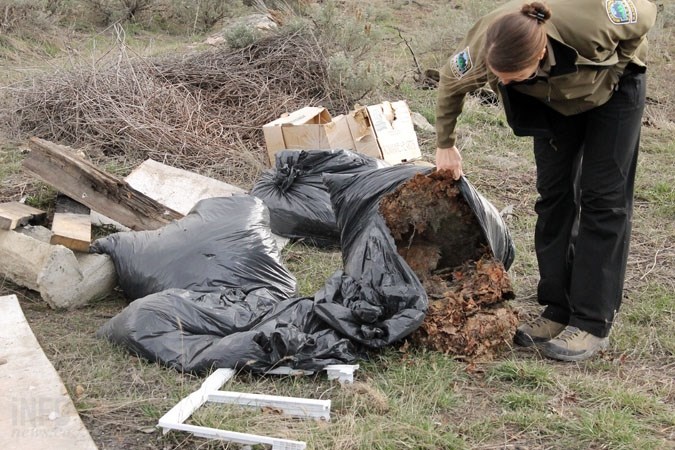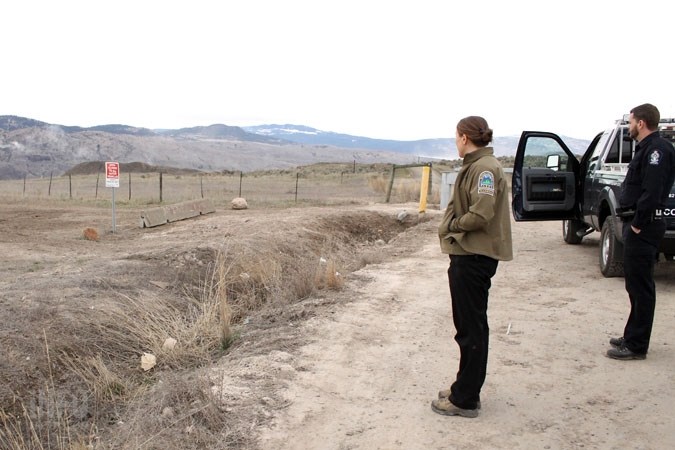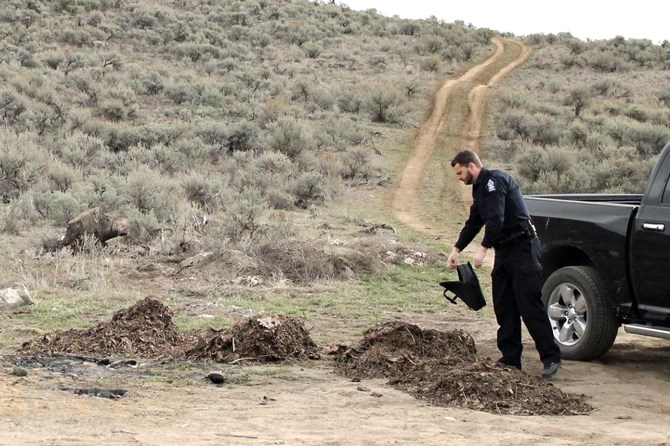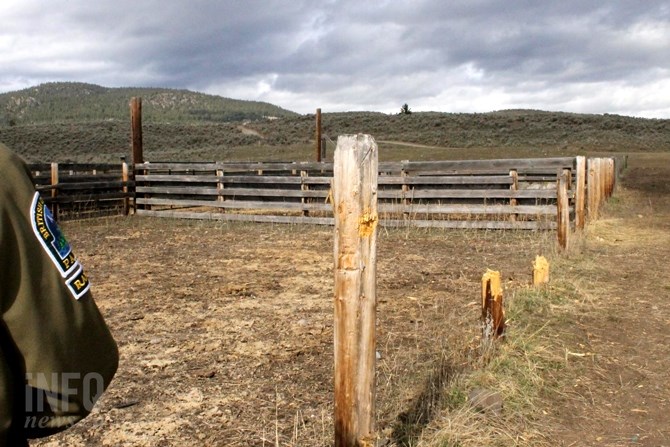
Weber-Roy checks out a bag of mulch illegally dumped on the side of the road
(GLYNN BROTHEN / iNFOnews.ca)
March 19, 2015 - 2:29 PM
KAMLOOPS – Watching several trucks drive by Batchelor Heights into the province's protected grasslands and not knowing the driver's purpose for visiting makes Park Ranger Amanda Weber-Roy nervous as she prepares for a day of work in the Lac du Bois Grasslands Saturday.
She looks for signs of recreational users — an ATV, a mountain bike or a horse trailer. But when she can't see them she wonders aloud if she or co-worker Conservation Officer Rob Armstrong will see something they might not want to that day.
Because of some scenes that already exist in the park, she's right to be concerned.
What's causing both officers grief runs the gamut between mudbogging, destroying property with bullet holes or fire and the most common — abandoned garbage.
“The problem doesn’t ever stop,” Weber-Roy says, adding that picking up garbage and replacing signs is not really the activity they want to be doing.
Both officers are part of a larger team looking after the 15,000 hectares of grasslands. Weber-Roy says there are several species within the park close to extinction. Thirty per cent of B.C.'s species at-risk reside in the local protected area, which is less than one per cent of the province's land base.
Between checking sites both officers will talk to users about the park. They regularly find and ticket those disrupting the land as well.
"It's fairly often that we're writing tickets," she notes. The range in fines is between $115 to $345 depending on the infraction.
Illegal dumping has been a sore spot in the area for as long as both Weber-Roy and Armstrong can remember. They say it's been worse in recent years and Weber-Roy worries it may worsen because of the city's increase in tipping fees.
"I'm sure it's going to have an impact on us more," she says.
Armstrong jokes people spend more money on gas to get out to the park than they would paying landfill fees.
SITE ONE: DRUGS AND SEX

Amanda Weber-Roy and Rob Armstrong survey the area where someone on an ATV ignored several barriers to protect the grasslands. But that's not the only problem in the park
(GLYNN BROTHEN / iNFOnews.ca)
The duo jumps into Armstrong’s work truck and head to their first site — a closed gate near the old shooting range. Armstrong says the range used to be free to the public, but was shut down off after too many people dumped garbage there. Now anyone with an interest in practicing their aim can do so for a price at the range near the highway.
A sign nearby reminds visitors species living in this area are protected. Weber-Roy points at it, a ditch, and cement barriers — all of which are designed to block vehicles from passing by. But she sighs when she sees the fresh ATV tracks running right past the sign into the grasslands.
“This is a popular spot for the drug crowd,” Armstrong says. He notes used condoms and dirty needles are items usually found among the party refuse.
But it’s not the weirdest things they’ve encountered in the park. Weber-Roy says every now and again she comes across appliances and torched living room sets.
“It’s like someone had a bad breakup and moved their partner’s stuff out here to burn it,” she jokes.
For Armstrong burned shells of abandoned vehicles are an unsettling, yet regular, sighting.
“It's not weird, it’s just disturbing,” he says.
SITE TWO: GARBAGE AND INVASIVE SPECIES

Conservation Officer Rob Armstrong checks the contents of a laptop bag dumped among a pile of garbage.
(GLYNN BROTHEN / iNFOnews.ca)
The officers pull up to what has become a dumping site to scope the abandoned bags of trash scattered throughout bricks and plywood. Weber-Roy is not surprised when she opens a kitchen bag to reveal yard waste.
What troubles Weber-Roy most is the leaves, soil and grass within the bags are free to dump at the landfill.
“You’re talking about five minutes from your day to drive it out there,” she says.
Because the soil and plants could contain seeds from other species, Weber-Roy says park rangers are never sure what could come their way.
“If you’re dumping some sort of flower from yard waste that’s not recognized by the natural grassland community – it could be a prolific seed producer,” Weber-Roy says. “Then we’re screwed. Invasive (species) can get out that way.”
She adds depending on the species they may not know how to curb its growth either. It could overtake other plants in the park, some of which are at-risk.
Armstrong smells the contents of a separate bag, checking to see if he can detect marijuana. He says people frequently dump leftovers from their pot grow-ops in the park.
He checks an old laptop bag to see if there's any evidence to identify its owner before he throws it back on the pile, commenting on how bad the case smells. Weber-Roy is quick to offer hand sanitizer.
Before getting back into the truck, Weber-Roy surveys the scene they’re about to leave. Given their objectives for the day, they can’t stick around to clean the trash. It will have to stay abandoned for now.
“It’s pretty depressing. I kind of feel powerless,” she says. “There are people that don’t have a problem (with this). This is the kind of stuff that keeps me up at night.”
She mentions local groups who regularly come and clean the park and keep a watchful eye on dumping or other illegal activities.
"They're really great about keeping me in the know about what's going on out here," she says.
SITE THREE: BULLETS AND FIRES

Signs are regularly used for target practice.
(GLYNN BROTHEN / iNFOnews.ca)
From a car window it’s easy to tell the litter on the cattle grazing lands and corral can threaten the livestock along with nearby wildlife. Armstrong and Weber-Roy side step around broken glass bottles, beer cans and batteries.
Leftover food items – egg shells, paper bags from fast-food joints and a half-empty jug of milk are odd sights in the pastoral setting.
Armstrong picks up a battery, which is free to recycle, and pockets it.
Park signs are a popular target throughout the grazing land; bullets are scattered throughout the area.
Weber-Roy has a rule when it comes to replacing metal signage. If it has more than 13 bullet holes or the message has become illegible, the sign is replaced. Replacing a single sign can cost around $200.
“We replace, I want to say, hundreds of signs a season,” she says.
Weber-Roy finds a nine-millimetre bullet from a handgun and spots a prairie dog target tacked on a post of the corral. While she removes the page full of holes, she addresses several wooden posts removed from the structure.
“People camping here didn’t bring firewood,” she says. “So they cut down part of the corral.”
There are several black spots on the ground with ashes from camp fires.
“I don’t know what were going to do about this. I don’t know where the money is going to come from to pay for this,” Weber-Roy says. “This is your park. This is your land.”

The posts from the corral were cut down and used as firewood.
(GLYNN BROTHEN / iNFOnews.ca)
This story is part three in a series. To read what city officials say on the park's pollution within city limits, click here.
To read what park users say on the conditions and cleanup at the park, click here.
To contact a reporter for this story, email gbrothen@infonews.ca, or call 250-319-7494. To contact the editor, email mjones@infonews.ca or call 250-718-2724.
News from © iNFOnews, 2015